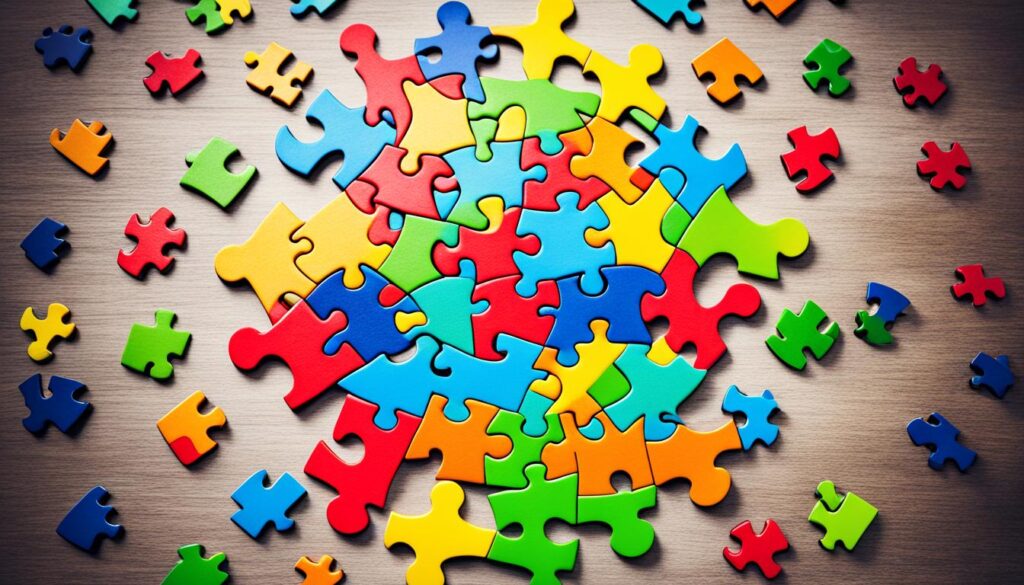Imagine a team of brilliant individuals coming together to tackle a complex problem. Each member is highly skilled and experienced in their respective fields, and they are all passionate about finding a solution. On paper, this team has all the necessary ingredients for success.
But what happens when these individuals struggle to communicate effectively? Or when conflicts arise due to differences in leadership styles? Suddenly, the team’s potential is hindered by internal friction and disunity.
This scenario highlights the importance of team dynamics elements in achieving success. Effective communication, trust building, conflict resolution, goal setting, problem solving, and collaboration techniques are the pillars that support productive teamwork. They are the driving forces behind a cohesive and high-performing team.
Key Takeaways:
- Team dynamics elements such as effective communication and trust building are crucial for success.
- Conflict resolution skills and collaboration techniques are essential for maintaining a harmonious team environment.
- Setting clear goals and objectives helps align the team’s efforts towards a shared vision.
- Problem-solving abilities enable teams to overcome challenges and find innovative solutions.
- By understanding and leveraging these key elements, teams can foster a positive and productive work environment.
Team Dynamics Definition
Team dynamics refers to the interactions and relationships between team members that can impact their productivity and performance. It encompasses how team members communicate, collaborate, and coordinate their efforts to achieve a shared goal.
Factors such as individual personality traits, work styles, attitudes, and external factors like organizational culture can influence team dynamics.
Importance of Team Dynamics
Effective team dynamics are crucial for a team’s success as they promote:
- Collaboration: Team members work together, combining their individual strengths and expertise to accomplish tasks and achieve goals.
- Productivity: With clear communication and coordination, teams can streamline processes, avoid duplication of efforts, and deliver results efficiently.
- Innovation: Encouraging diverse perspectives and fostering an environment of trust and open communication promotes creativity and the generation of new ideas.
- Problem-solving: Effective team dynamics enhance problem-solving capabilities by leveraging the collective intelligence, skills, and experiences of team members.
- Employee Engagement: Positive team dynamics cultivate a sense of belonging, job satisfaction, and motivation among team members, leading to higher employee engagement and retention.
Impact of Individual Factors on Team Dynamics
Various individual factors can influence team dynamics:
| Factors | Impact on Team Dynamics |
|---|---|
| Personality Traits | Different personalities may lead to varying communication styles, preferences for collaboration, and approaches to problem-solving. |
| Work Styles | Individual work styles may affect how team members contribute, coordinate tasks, and adapt to teamwork. |
| Attitudes | Positive attitudes, such as openness, adaptability, and willingness to collaborate, contribute to constructive team dynamics. |
| External Factors | Organizational culture, team environment, and leadership styles play a significant role in shaping team dynamics. |
“Teamwork is the ability to work together toward a common vision. The ability to direct individual accomplishments toward organizational objectives. It is the fuel that allows common people to attain uncommon results.”
– Andrew Carnegie
Key Elements of Team Dynamics
Effective team dynamics rely on several key elements that contribute to a productive and harmonious working environment. These elements include:
- Communication: Efficient and open communication forms the foundation of successful team dynamics. It involves active listening, expressing ideas clearly, and providing constructive feedback. By promoting effective communication, team members can fully understand each other’s perspectives and collaborate more efficiently.
- Trust Building: Trust is a crucial element in fostering strong team dynamics. It creates an environment where team members feel safe sharing ideas and information. Through trust, team members can rely on one another, collaborate effectively, and work towards achieving common goals.
- Roles and Responsibilities: Clearly defined roles and responsibilities provide structure and clarity within a team. This ensures that each team member understands their specific tasks and duties, as well as who they can turn to for assistance. When roles and responsibilities are well-defined, it enhances accountability and prevents confusion or duplication of efforts.
- Diversity and Inclusion: Embracing diversity and inclusion within team dynamics leads to a broader range of perspectives, ideas, and approaches. Different backgrounds, experiences, and skills contribute to a more innovative and creative team. By valuing diversity, teams can leverage the strengths of individual members and foster a culture of inclusivity and collaboration.
- Conflict Resolution: Conflict is inevitable within any team, but how it is managed can significantly impact team dynamics. Conflict resolution skills are essential for addressing and resolving conflicts constructively. By promoting open communication, active listening, and finding mutually beneficial solutions, teams can navigate conflicts in a respectful and productive manner.
To visualize the key elements of team dynamics more effectively, refer to the table below:
| Key Elements | Description |
|---|---|
| Communication | Effective communication involves active listening, clear expression of ideas, and providing feedback. |
| Trust Building | Trust creates a safe environment for sharing ideas and information, fostering collaboration among team members. |
| Roles and Responsibilities | Clearly defined roles and responsibilities ensure that team members understand their tasks and who to approach for assistance. |
| Diversity and Inclusion | Embracing diversity brings different perspectives and ideas, leading to more innovative and creative solutions. |
| Conflict Resolution | Conflict resolution skills are vital for addressing and resolving conflicts constructively. |

Factors that Affect Team Dynamics
Team dynamics can be influenced by various factors that impact how team members collaborate and work together. Let’s explore some of these key factors:
1. Leadership Styles
The leadership style within a team can significantly influence its dynamics. Effective leaders play a crucial role in optimizing team performance by demonstrating strong leadership skills and fostering trust and open communication among team members.
2. Organizational Culture
The culture of an organization sets the tone for team dynamics. An inclusive and supportive organizational culture promotes a positive team environment where members feel valued and motivated to collaborate and contribute to the team’s success.
3. Individual Personalities
Each team member brings their unique personality traits and characteristics, which can influence how they interact and collaborate with others. Understanding and appreciating these differences can help create a harmonious and productive team dynamic.
4. Goals and Objectives
Clearly defined goals and objectives provide the team with a sense of direction and purpose. When team members have a shared understanding of what they are working towards, it fosters alignment and enhances team dynamics.
Effective team dynamics rely on strong leadership, an inclusive organizational culture, synergy among diverse personalities, and clearly defined goals and objectives.
Considering these factors and their impact on team dynamics is essential for team leaders and members to create a cohesive and high-performing team.
Next, we will explore the benefits that strong team dynamics can bring to an organization’s success.
Benefits of Strong Team Dynamics
Strong team dynamics can have a powerful impact on an organization, leading to improved productivity, higher job satisfaction, increased innovation, better decision-making, and better employee retention. When team members work well together, they are able to collaborate and complete tasks more efficiently and effectively, resulting in improved productivity and overall team performance. Moreover, the implementation of strengthsbased team building strategies can further enhance these positive outcomes by focusing on each member’s unique talents and skills. By recognizing and leveraging individual strengths, teams not only foster a collaborative environment but also increase overall morale, as employees feel valued and understood. As a result, organizations can cultivate a culture of continuous improvement, driving both individual and collective success.
A positive team environment promotes job satisfaction and engagement among employees. When team members feel supported and valued within their team, they are more likely to enjoy their work and feel motivated to contribute their best efforts. This elevated job satisfaction can lead to higher levels of employee happiness and loyalty, contributing to improved employee retention.
Collaboration and the integration of diverse perspectives within a team can spark innovation. When individuals with different backgrounds, experiences, and skill sets come together, they bring a wide range of ideas and approaches to problem-solving. This diversity can stimulate creativity and generate innovative solutions that drive the organization forward.
Effective teamwork and collaboration also result in better decision-making. When a team is able to work together cohesively, they can combine their expertise and insights to make informed decisions. The collective intelligence and varied perspectives of team members contribute to more thorough analysis, thoughtful consideration of options, and ultimately, better decision outcomes.
Positive team dynamics contribute to a welcoming and professional work environment, fostering a sense of belonging and inclusivity. When team members feel comfortable expressing their opinions, ideas, and concerns, it creates a safe space for open communication and collaboration. This supportive environment enhances employee satisfaction and engagement, ultimately contributing to better overall team performance and success.

Benefits of Strong Team Dynamics:
- Improved productivity
- Higher job satisfaction
- Increased innovation
- Better decision-making
- Better employee retention
Conclusion
Effective team dynamics are essential for the success of any team. By understanding and actively managing team dynamics, leaders can foster effective communication, collaboration, and trust among team members. This leads to increased productivity, job satisfaction, innovation, and retention of talented individuals. Moreover, recognizing the unique strengths and weaknesses of each team member allows for a more tailored approach to fostering teamwork. Teams that prioritize healthy team dynamics in successful organizations are often more adaptable and resilient in the face of challenges. Ultimately, a focus on team dynamics not only enhances performance but also contributes to a positive workplace culture that attracts and retains top talent.
When team members work well together and have a positive team environment, they can achieve their goals more efficiently and effectively. This results in improved productivity, as tasks are completed in a streamlined and coordinated manner. Additionally, team members experience higher job satisfaction and engagement, as they feel valued and supported within the team.
Positive team dynamics also promote innovation and better decision-making. When team members come from diverse backgrounds and have different perspectives, they can bring new ideas and insights to the table. This fosters creativity and innovation, leading to unique solutions and approaches. Furthermore, effective teamwork and collaboration enable team members to make better-informed decisions by leveraging the collective knowledge and expertise of the team.
By fostering positive team dynamics, organizations can create a high-performing team that not only achieves its goals but also contributes to the overall success of the organization. A strong and cohesive team that communicates effectively, collaborates efficiently, and trusts one another becomes a valuable asset to the organization. The benefits include increased productivity, innovation, and employee retention, ultimately impacting the success and profitability of the organization as a whole.
FAQ
What are team dynamics?
Team dynamics refer to the relationships and interactions between team members that can affect their productivity and performance. It encompasses how team members communicate, collaborate, and coordinate their efforts to achieve a shared goal.
What are the key elements of team dynamics?
The key elements of team dynamics include effective communication, trust building, clearly defined roles and responsibilities, diversity and inclusion, and conflict resolution.
What factors can affect team dynamics?
Factors that can affect team dynamics include leadership styles, organizational culture, individual personalities, and the clarity of goals and objectives.
What are the benefits of strong team dynamics?
Strong team dynamics have several benefits, including improved productivity, higher job satisfaction, increased innovation, better decision-making, and better employee retention.
How can team dynamics contribute to the success of a team?
By understanding and actively managing team dynamics, leaders can foster effective communication, collaboration, and trust among team members. This leads to increased productivity, job satisfaction, innovation, and retention of talented individuals.


